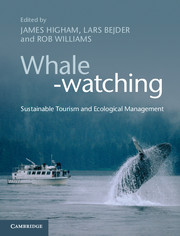Book contents
- Frontmatter
- Dedication
- Contents
- Acknowledgements
- List of contributors
- List of abbreviations
- 1 Tourism, cetaceans and sustainable development
- Part I The historical and contemporary contexts
- Part II Human dimensions of whale-watching
- Part III Ecological dimensions of whale-watching
- Part IV Sustainable management: insights and issues
- 18 The socioeconomic, educational and legal aspects of whale-watching
- 19 Vigilance, resilience and failures of science and management
- 20 Insights from agent-based modelling to simulate whale-watching tours
- 21 Cetacean-watching in developing countries
- 22 Kaikoura (New Zealand)
- 23 Management of dusky dolphin tourism at bKaikoura, New Zealand
- 24 Save the whales Part II
- 25 Time to rethink
- Index
- Plate Section
- References
20 - Insights from agent-based modelling to simulate whale-watching tours
Influence of captains’ strategy on whale exposure and excursion content
from Part IV - Sustainable management: insights and issues
Published online by Cambridge University Press: 05 April 2014
- Frontmatter
- Dedication
- Contents
- Acknowledgements
- List of contributors
- List of abbreviations
- 1 Tourism, cetaceans and sustainable development
- Part I The historical and contemporary contexts
- Part II Human dimensions of whale-watching
- Part III Ecological dimensions of whale-watching
- Part IV Sustainable management: insights and issues
- 18 The socioeconomic, educational and legal aspects of whale-watching
- 19 Vigilance, resilience and failures of science and management
- 20 Insights from agent-based modelling to simulate whale-watching tours
- 21 Cetacean-watching in developing countries
- 22 Kaikoura (New Zealand)
- 23 Management of dusky dolphin tourism at bKaikoura, New Zealand
- 24 Save the whales Part II
- 25 Time to rethink
- Index
- Plate Section
- References
Summary
Introduction
Multi-agent models can bear several names depending on the field they were initially developed in (e.g. agent-based model in social science, individual-based model in ecology). Agent- and individual-based models (ABMs and IBMs) are becoming tools of choice to simulate complex social–ecological systems (Gimblett, 2002; Janssen & Ostrom, 2006; Monticino et al., 2007; Bennett & McGinnis, 2008). The recent development of dedicated programming platforms and libraries has also contributed to the expansion of multi-agent models coupled with geographic information systems (GIS) (Railsback et al., 2006). Such models have been applied in a wide variety of natural resource management contexts where heterogeneous actors interact, including rangeland management in arid zones (Gross et al., 2006), management of water use and access in river basins (Schlüter & Pahl-Wostl, 2007), control of irrigation channels (van Oel et al., 2010), agriculture management (Manson, 2005), and forest clearing for agriculture (Moreno et al., 2007). ABMs have also been used to support national parks and recreation areas' managers by simulating visitor movements to predict over-crowded areas along vehicular routes and hiking trails (Itami et al., 2003), or along riverside rest areas and attraction sites for rafting trips on the Colorado River (Roberts et al., 2002).
Information
- Type
- Chapter
- Information
- Whale-watchingSustainable Tourism and Ecological Management, pp. 293 - 306Publisher: Cambridge University PressPrint publication year: 2014
